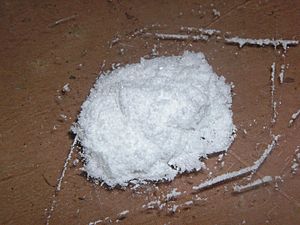Dissociative facts for kids
Dissociatives are a special type of drug. They can make a person feel like they are separated from their own body or from the world around them. This feeling is called "dissociation."
Doctors sometimes use dissociatives as anesthetics. This means they help people become unconscious during medical operations so they don't feel pain. They are often used for animals or children in these situations because these patients might not notice the unusual feelings the drugs can cause.
Contents
How Dissociatives Affect the Brain
Dissociatives change how people perceive things. They can cause hallucinations, which are seeing or hearing things that aren't really there. They might also make someone feel like they are in a trance or feel very happy, a feeling called euphoria.
Most dissociatives work by blocking a chemical in the brain called glutamate. Glutamate is very important for how our brains handle memory and pain. Some dissociatives, like those from the Salvia divinorum plant, travel through the bloodstream and connect to certain spots in the brain called opioid receptors. Other types might connect to dopamine receptors instead.
Common Dissociatives
Some of the most well-known dissociatives around the world include ketamine, phencyclidine (PCP), and dextromethorphan (often called DXM).
Recreational Use and Legality
Because of the unusual feelings they create, some people use dissociatives for fun. However, in many countries, it is illegal to use these substances without a doctor's prescription. Using them this way can be very dangerous and has serious legal consequences.
See also
 In Spanish: Droga disociativa para niños
In Spanish: Droga disociativa para niños


